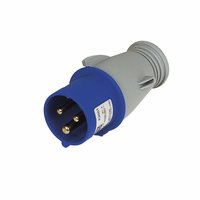Call Us Now:
0345 193 0615
 IP Ratings are an intermational classification system used to define the the sealing effectiveness of the enclosures of electrical and mechanical products. IP ratings given to products allow users to know immediately how well they are protected against solid items (such as tools, dust, and fingers) and moisture.
IP Ratings are an intermational classification system used to define the the sealing effectiveness of the enclosures of electrical and mechanical products. IP ratings given to products allow users to know immediately how well they are protected against solid items (such as tools, dust, and fingers) and moisture.
The full standard is known as IEC/EN 60529, and the ratings are developed by the European Committee for Electro Technical Standardization (CENELEC). The code specifies the environmental protection an enclosure provides. A good example would industrial ‘commando’ electrical connectors like the one shown above which are IP44 rated. So, the question we are looking to address here is ‘What does that IP number mean?’
The Letters
All IP ratings start with the letters IP (for “Ingress Protection”) followed by two or three digits. The letter ‘X’ is used instead of a digit where there is only one class of protection – for example IPX4 addresses moisture resistance only.
The First Digit
The first digit of the IP code indicates the degree to which persons are protected against moving parts other than smooth rotating shafts etc., and the degree to which the equipment is protected against solid foreign bodies intruding into an enclosure. The following list defines those protection levels:
| 0 | No special protection |
| 1 | Protection from accident access of part of the body such as a hand or objects greater than 50mm |
| 2 | Protection against fingers or other objects not greater than 80mm in length and 12mm in diameter |
| 3 | Protection from entry by tools, wires etc. with a diameter or thickness greater than 2.5mm |
| 4 | Protection from entry by solid objects with a diameter or thickness greater than 1.0mm |
| 5 | Protection from the amount of dust that would interfere with the operation of the equipment |
| 6 | Dust tight |
The Second Digit
The second digit of the IP code indicates the degree to which the equipment inside the enclosure is protected from the harmful entry of various types of moisture such as splashing, dripping, submersion etc. The following list defines those protection levels:
| 0 | No special protection |
| 1 | Protected against vertically falling drops of water |
| 2 | Protected against direct sprays up to 15o from the vertical |
| 3 | Protected against direct sprays up to 60o from the vertical |
| 4 | Protected against sprays from all directions – limited ingress permitted |
| 5 | Protected against low pressure jets if water from all directions – limited ingress permitted |
| 6 | Protected against strong jets of water e.g. for use on shipdecks – limited ingress permitted |
| 7 | Protected against the effects of temporary immersion between 15cm and 1m. Duration of test 30 minutes |
| 8 | Protected against long periods of complete continuous immersion in water under pressure – submersion depth and time must be specified by the end user. The requirement must be more onerous than IP67. |
Additonal Letters
The standard defines some letters that can be added to classify the level of protection against access to hazardous parts by persons. The following list defines those protection levels:
| A | Back of hand |
| B | Finger |
| C | Tool |
| D | Wire |
Supplementary Letters
More letters can be added to provide additional information about the protection of the device. The following list defines those letters:
| H | High voltage device |
| M | Device moving during water test |
| S | Device standing still during water test |
| W | Weather conditions |
IP69K
German standard DIN 40050-9 extends the IEC 60529 rating system described above with an IP69K rating for high-pressure, high-temperature wash-down applications. Such enclosures must not only be dust tight (IP6X), but also able to withstand high-pressure and steam cleaning. The test specifies a spray nozzle that is fed with 80 °C water at 8–10 MPa (80–100 bar) and a flow rate of 14–16 L/min. The nozzle is held 10–15 cm from the tested device at angles of 0°, 30°, 60° and 90° for 30 s each. The test device sits on a turntable that rotates once every 12 s (5 rpm).
The IP69K test specification was initially developed for road vehicles, especially those that need regular intensive cleaning (dump trucks, cement mixers, etc), but also finds use in other areas (e.g., food industry).
References
If you are seeking information on IP ratings but cannot find it here, please email us and we will try to both answer your question and make sure that the information is made available through these pages for future reference.
Leads Direct makes great efforts to provide accurate and complete information. However, portions of the information contained in this website and any documents viewed on it or downloaded from it may be incorrect or not current. Any errors or omissions should be reported for investigation and correction. The information provided in any documents whether on our website or otherwise is provided "as is." No warranty of any kind, implied, expressed, or statutory, including but not limited to the warranties of non-infringement of third party rights, title, merchantability, fitness for a particular purpose, and freedom from computer virus, is given.